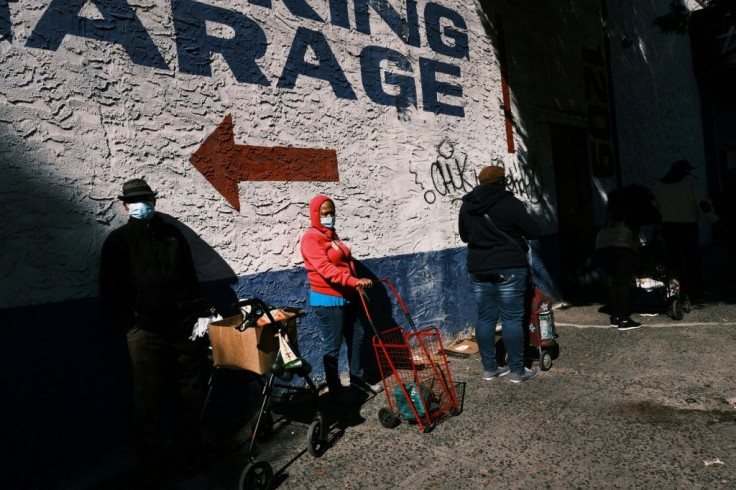Economic Damage In US From Year-end Covid Surge Becomes Clear
The nationwide surge in Covid-19 infections took its toll on the United States in the final weeks of 2020, stalling rehiring and heightening fears of a renewed malaise in the world's largest economy even as vaccine coverage increases.
Labor Department data released Thursday showed 787,000 people, seasonally adjusted, filed new applications for unemployment benefits in the last week of the year, barely changed from the week prior and nowhere near the record-low unemployment seen before Covid-19 broke out in the country in March.
The Institute for Supply Management (ISM) reported better-than-expected growth in the services sector in December, but many firms complained they were feeling the effects of skyrocketing Covid-19 infections, and employment in the sector slumped back in to contraction.
"The underlying story here is clear. A combination of Covid fear and state-mandated restrictions on activity in the services sector is squeezing businesses, and no real relief is likely until a sustained decline in pressure on hospitals emerges," said Ian Shepherdson of Pantheon Macroeconomics.
The data is a worrying sign for the December employment report that the Labor Department will release Friday, which analysts expect will show the economy adding 112,000 jobs and the unemployment rate remaining unchanged at 6.7 percent.
"Brace (for) job creation to be flat-to-negative when the data (for) December comes out tomorrow," Diane Swonk of Grant Thornton wrote on Twitter, predicting an increase of 100,000 jobs that "is not significantly different than zero for the month."
The US was gripped by twin crises in 2020, dealing with a seemingly unstoppable Covid-19 outbreak that has infected more than 21.3 million people and killed nearly 362,000 as of Thursday, according to Johns Hopkins University.
States' efforts to stop the virus by ordering many businesses to close or restrict activities caused massive layoffs beginning in March that moderated over the summer as those regulations were relaxed.
But many states again tightened rules on employers as Covid-19 cases began climbing again in the winter, slowing the recovery in the labor market and keeping the weekly new claim filings at a level above the single worst week of the 2008-2010 global financial crisis.
On top of those who filed regular claims, the Labor Department said an 161,460 people, without seasonal adjustment, filed claims under the Pandemic Unemployment Assistance (PUA) program for workers not normally eligible for government benefits in the week ended January 2.
That was much lower than in prior weeks, but the program briefly lapsed in that period after a down-to-the-wire battle between Congress and President Donald Trump over extending it and other aid in a massive spending bill, meaning PUA filings could increase next week.

The data also contained signs that long-term joblessness is getting worse, with the number of people receiving aid under the Extended Benefits program that is only available in states with high unemployment rising by 148,651 to 951,364 as of the week ended December 19.
All told, around 19.2 million people continued to receive aid from all government unemployment programs as of that week, the report said.
ISM said its service sector index climbed above expectations to 57.2 percent in December on the strength of new orders and production.
However Oren Klachkin of Oxford Economics warned an increase in the supplier deliveries index, indicating slower delivery times, gave "artificial support" to the overall index, while employment dropped below the 50-percent level indicating expansion.
And many companies surveyed warned that the worsening pandemic was hitting their operations.
"Between Covid-19, the holidays, and inclement weather of late, the remainder of (2020) stands to be very challenging regarding maintaining adequate materials for operations," a professional, scientific and technical services company told ISM.
The massive spending measure Congress enacted at the end of 2020 contains provisions that could support the economy and services sector at large, including stimulus checks to taxpayers and extensions of the PUA and other special unemployment aid programs.
The Treasury Department on Thursday also announced it would distribute $25 billion in relief funds paid for in the law to help people unable to cover rent or utility costs because of the pandemic.
The services sector is a major employer for Americans, and Klachkin said he expects it to benefit from government stimulus, which could increase now that Democrats control both houses of Congress.
"Vaccine distribution and fresh pandemic relief will support a stronger recovery of the hardest-hit service sector after winter ends," he said.
"We caution however that near-term recovery risks remain tilted to the downside as the health situation continues spiraling."
© Copyright AFP {{Year}}. All rights reserved.





















